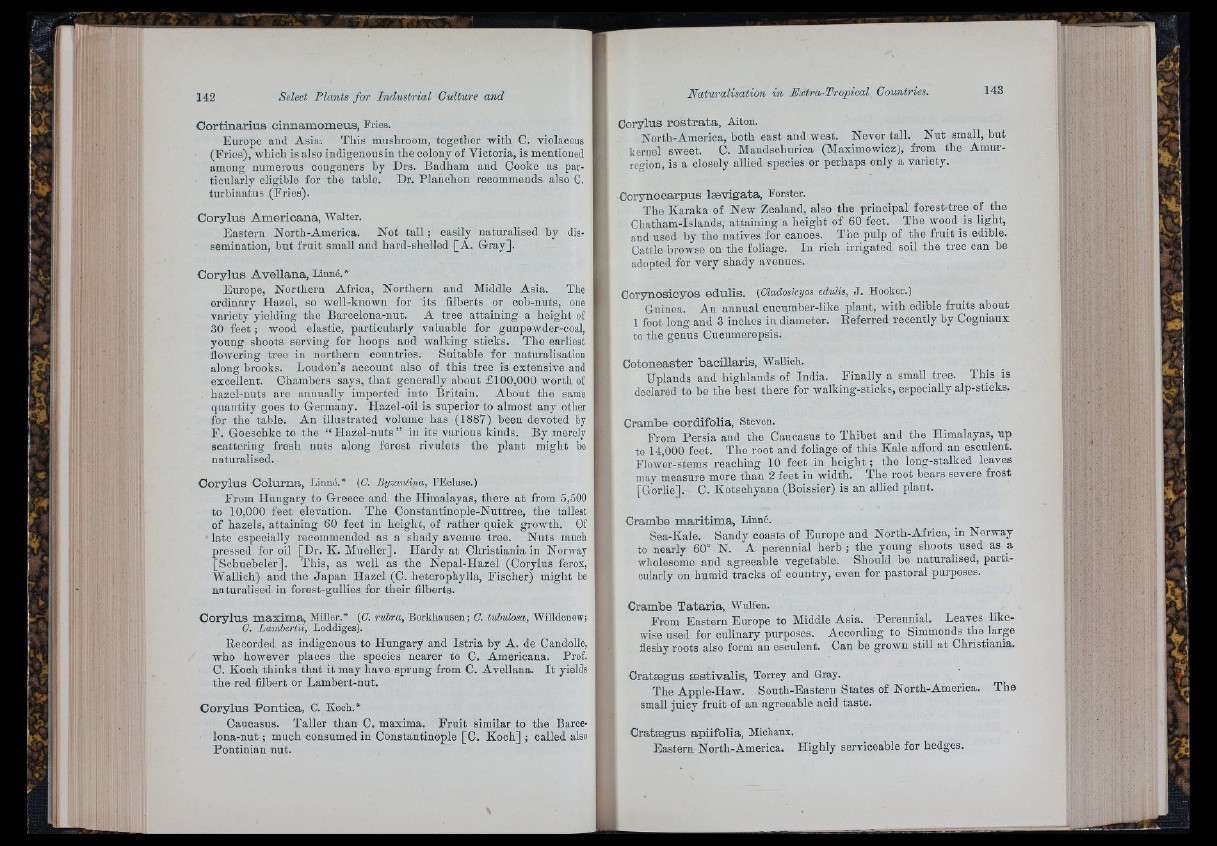
':■ 'i ■- ■ ' ,'■
iii !'
C o r t in a r i u s c in n am om e u s , Fries.
Europe and Asia. This mushroom, together with C. violaceus
(Fries), which is also indigenous in the colony of Victoria, is mentioned
among numerous congeners by Drs. Badham and Cooke as particularly
eligible for the table. Dr. Planchón recommends also C.
turbinatus (Fries).
C o r y lu s A m e r ic a n a , Walter.
Eastern North-America. Not tall ; easily naturalised by dissemination,
but fruit small and hard-shelled [A. Gray].
C o r y lu s A v e lla n a , Linné.*
Europe, Northern Africa, Northern and Middle Asia. The
ordinary Hazel, so well-known for its filberts or cob-nuts, one
variety yielding the Barcelona-nut. A tree attaining a height of
30 feet ; wood elastic, particularly valuable for gunpowder-coal,
young shoots serving for hoops and walking sticks. The earliest
flowering tree in northern countries. Suitable for naturalisation
along brooks. Loudon’s account also of this tree is extensive and
excellent. Chambers says, th a t generally about £100,000 worth of
hazel-nuts are annually imported into Britain. About the same
quantity goes to Germany. Hazel-oil is superior to almost any other
for the table. An illustrated volume has (1887) been devoted by
F . Goeschke to the “ Hazel-nuts ” in its various kinds. By merely
scattering fresh nuts along forest rivulets the plant might be
naturalised.
C o r y lu s C o lu rn a , Linné.* (O'. Byzantina, I’Eoluse.)
From Hungary to Greece and the Himalayas, there a t from 6,500
to 10,000 feet elevation. The Constantinople-Nuttree, the tallest
of hazels, attaining 60 feet in height, of rather quick growth. Of
late especially recommended as a shady avenue tree. Nuts much
messed for oil [Dr. K. Mueller]. Hardy at Christiania in Norway
"Schuebeler]. This, as well as the Nepal-Hazel (Corylus ferox,
Wallich) and the Japan Hazel (C. heterophylla, Fischer) might he
naturalised in forest-gullies for their filberts.
C o r y lu s m a x im a . Miller.* (0. rubra, Borkhausen; 0. tubulosa, Willdenowj
0. Lambertii, Loddiges).
Recorded as indigenous to Hungary and Istria by A. de Candolle,
who however places the species nearer to C. Americana. Prof.
0 . Koch thinks that it may have sprung from C. Avellana. I t yields
the red filbert or Lambert-nut.
C o r y lu s P o n t i c a , C. Koch.*
Caucasus. Taller than C. maxima. F ru it similar to the Barcelona
nut ; much consumed in Constantinople [C. Koch] ; called also
Pontinian nut.
C o ry lu s r o s t r a t a , Aiton.
North-America, both east and west. Never tall. N u t small, but
kernel sweet. C. Mandscburica (Maximowicz), from tlie Amur-
region, is a closely allied species or perhaps only a variety.
C o ry n o c a rp u s læ v ig a t a , Forster.
The Karaka of New Zealand, also the principal forest-tree of the
Chatham-Islands, attaining a height of 60 feet. The wood is light,
and used by the natives for canoes. The pulp of the fruit is edible.
Cattle browse on the foliage. In rich irrigated soil the tree can he
adopted for very shady avenues.
C o ry n o s io y o s e d u lis . (Gladoskyos edulia, J . Hooker.)
Guinea. An annual cuoumber-like plant, with edible fruits about
1 foot long and 3 inches in diameter. Referred recently by Cogniaux
to the genus Cucnmeropsis.
C o to n e a s te r b a c illa r is , Wallich,
Uplands and highlands of India. Finally a small tree. This is
declared to be the best there for walking-sticks, especially alp-stioks.
C ram b e c o rd ifo lia , Steven.
From Persia and the Caucasus to Thibet and the Himalayas, up
to 14,000 feet. The root and foliage of this Kale afford an esculent.
Fiower-stems reaching 10 feet in height ; the long-stalked leaves
may measure more than 2 feet in width. The root bears severe frost
[Gorlie]. 0 . Kotsohyana (Boissier) is an allied plant.
C ram b e m a r i t im a , Linné.
Sea-Kale. Sandy coasts of Europe and North-Africa, in Norway
to nearly 60° N. A perennial herb ; the young shoots used as a
wliolesome and agreeable vegetable. Should be naturalised, particularly
on humid tracks of country, even for pastoral purposes.
C ram b e T a t a r i a , Wulfen.
From Eastern Europe to Middle Asia. Perennial. Leaves likewise
used for culinary purposes. According to Simmonds the large
fleshy roots also form an esculent. Can be grown still a t Christiania.
C r a tæ g u s æ s t iv a l i s , Torrey and Gray.
The Apple-Haw. South-Eastern States of North-America. The
small juicy fruit of an agreeable acid taste.
C r a tæ g u s a p iifo lia , Michaux.
Eastern North-America. Highly serviceable for hedges.
i.'
il 'i.
ll'-ÏTU
¿ f r i ' :-b A:
fr